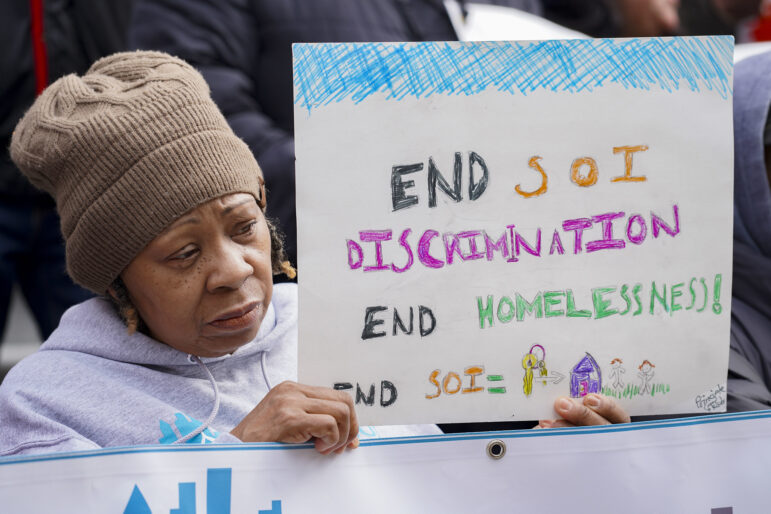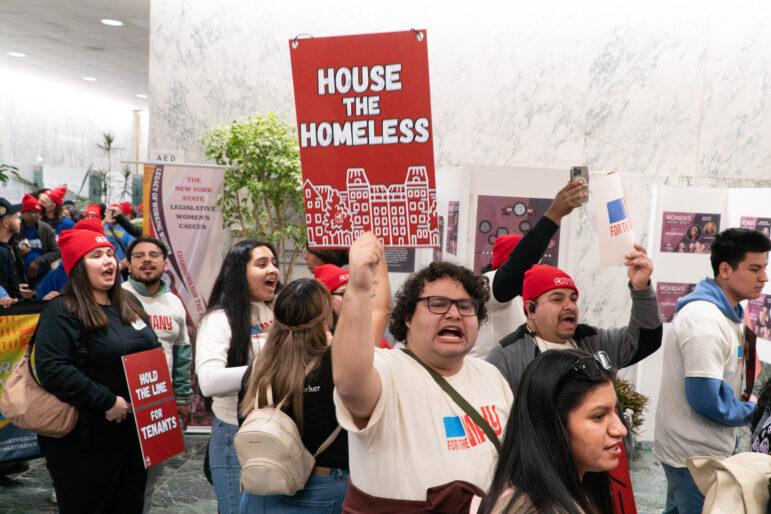
This Year's Love
It was mid-February and business as usual at the Bed-Stuy Campaign Against Hunger on Fulton Street in Brooklyn. A truck stood parked outside, and a case of canned fruit sat next to the front steps. The storefront office, with photos of the organization’s neighboring food pantry lining its orange and white walls, was standing room only. Brooklynites, bundled for the cold winter weather, sat in nearly every available chair and lined the center aisle waiting for the number on the laminated paper that they’d been given to be called. An employee stood at the front of the room telling everyone to keep the aisles free when a woman in the crowd spoke up.
“Are we going to get them in March?” she asked referring to her Supplemental Nutrition Assistance Program benefits.
People fixed their attention on the employee, waiting for a response.
“We don’t know,” the employee said.
This exchange speaks to the confusion that the early dispersal of February Supplement Nutrition Assistance Program benefits, triggered by the December-January federal government shutdown, caused many households across the city, the state and the country.
Get the best of City Limits news in your inbox.
Select any of our free weekly newsletters and stay informed on the latest policy-focused, independent news.
Uncertainty about how long the government shutdown would drag on prompted New York state and other states to act. Their respective agencies dispersed both January and February SNAP benefits to many households in January.
Then families were left in a bureaucratic limbo for a few weeks wondering when they could rely on those benefits again. These are benefits that 2.9 million New Yorkers, that’s one in seven residents, depend on to eat. Fifty-five percent of the households that receive SNAP have children in them.
While the date is now set for when March benefits will go out — by March 7 according to a press release from Governor Cuomo’s office — the longer term effects of the early dispersal remain unknown, advocates say.
And while they wait for their March benefits, many households will face what is called a “SNAP Gap” — the time period when a family runs out of their SNAP benefits and relies on emergency food assistance from places like the Bed-Stuy Campaign Against Hunger until they get the next round.
According to a report by the U.S. Department of Agriculture, nearly 50 percent of SNAP benefits went to youths under the age of 18 in 2016.
“This is unprecedented. There has never once been this mass early issuance of SNAP benefits,” says Sherry Tomansky the director of communications and public affairs at Hunger Solutions New York, a statewide organization based in Albany that seeks to combat hunger by helping people enroll in federal programs like SNAP. “We have not fully seen the impact of this enormous time lag.”
Tomansky pointed out that SNAP was one of the few public assistance programs that experienced a real disruption during the shutdown.
“Every time you issue early, you create a gap for the next month,” Tomansky says referring to the March dispersal, which will happen a week early in New York State. “This shutdown is a distant memory for a lot of people but it continues to loom large and present in the lives of people who rely on SNAP”
The New York City Human Resources Administration, the agency that distributes SNAP in the city, and Cuomo’s office both did not respond to a request for comment.
On average, New York distributes just over $1.50 per meal per person in SNAP benefits each month. In a normal month, most households run out of their benefits by the third week leaving them to rely on food pantries, Tomansky says. How each household managed receiving two months upfront is yet to be seen.
Chase Orlean, 56, a SNAP beneficiary who lives a couple of blocks away from the Bed-Stuy Campaign Against Hunger says that she and her family, which includes an 8-year-old granddaughter, haven’t felt the effects of the early dispersal yet because she’s careful each month with how she feeds her family.
“You just have to know how to ration it,” says Orlean about her benefits. Each month she supplements her benefits by going to food pantries and soup kitchens. She says she cooks each night at home and spends about $80 a month on fruits and vegetables for her granddaughter.
Daniel Wright, a benefits manager at the Bed-Stuy Campaign Against Hunger who helps people register for SNAP, says that he had more people stop by his desk with questions after the early dispersal. He says his organization tried to get the word out so that the people who did receive the early benefits would know to ration it.
“People were told and warned to be careful,” he says. “I’m not sure everyone heeded to that.”
Food is expensive, he says, and SNAP benefits go quickly. He says he thought that some people might have even spent it without realizing they’d received their benefits a month early.
But he says it was good that the shutdown ended.
“Had they not done that and had the shutdown gone through, people would have really had a hard time,” says Wright.
Joel Berg, the CEO of the New York based organization Hunger Free America, says that it was difficult to know how many people understood why they got extra money in January on their EBT card and whether they knew they needed to ration it.
“We don’t know how much was spent on perishable food or nonperishable food that was immediately consumed or whether people understood this was going to be an issue and bought more nonperishable food or perishable food that was frozen,” he says.
Berg says that low-income people don’t get cash benefits anymore and SNAP tends to be the last support available to them.
“What this does highlight is how inadequate the normal benefits are. If these higher benefits were eaten up immediately, it’s not like low-income people are spending it on caviar or something,” he says. “They are struggling just to survive.”
CityPlate, City Limits’ series on food policy, is supported by the Laurie M. Tisch Illumination Fund. City Limits is solely responsible for the content.










2 thoughts on “Federal Shutdown Created Unprecedented Gap at Low-Income Dinner Tables”
Pingback: The shutdown brought people who rely on SNAP an extra helping of economic hardship | DJG Blogger
Pingback: The shutdown brought people who rely on SNAP an extra helping of economic hardship